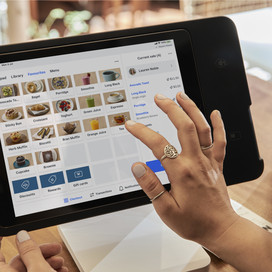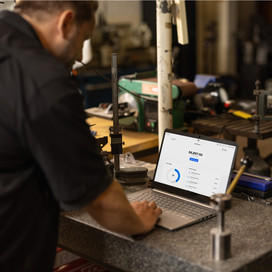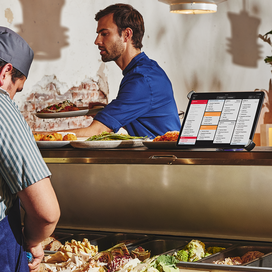Table of contents
Dreaming of starting your own restaurant? Before you get cooking, you’ll need a restaurant concept – one that works for you and your future customers. Getting it right could be the difference between struggling to fill tables or queues out your door.
What is a restaurant concept?
A restaurant concept is what defines a restaurant – it’s what makes it yours and separates it from the crowd. Your restaurant concept doesn’t have to be something totally new, though. In fact, chances are you’re going to take inspiration from the local or international culinary landscape.
Perhaps you’ve got an idea for the next Fishbowl, whose co-owners had a desire for healthy fast food and saw a gap in the market. Their first store opened in Bondi in 2016, and since then, they’ve launched over 40 stores across Australia.
Or maybe you’ll create the next enduring icon. Vegie Bar was one of the first vegetarian eateries in Melbourne when it began as a small takeaway shop in 1988. Over three decades later, it’s now an institution with a sister fine-dining restaurant, as well as a gelato shop next door.
How to decide on a restaurant concept
There are many things to consider, but these steps will take you through the process, from the first spark of inspiration to making your dream a reality.
1. Identify a vision and goals
Your vision might be crystal clear, or you might just have a feeling that a restaurant is the right business for you. If you’re not yet settled on a single concept, you can start by thinking about the food you love and your most memorable dining experiences. Is there a cuisine that’s your speciality? What about something you wished existed but doesn’t?
Consider what your ideal concept looks like and what you want to achieve with it. You may aim to start small and expand to multiple locations. Or perhaps you’ll be happy with a single business that does steady trade year in, year out. How active do you want to be in the day-to-day operations? And where do you see your restaurant in five, 10 or 20 years? The more you can put down on paper, the better.
2. Research market trends and demographics
It always pays to do a bit of market research before starting a new enterprise. Most importantly, you’ll need to investigate your potential customer base and find out what they’re looking for in a restaurant. You’ll also want to check out your competition, especially locally, and size up how your concept and offering compare to theirs.
There are a few methods for doing this type of research, including surveys, interviews and focus groups. Market research in the restaurant business is also a perfect excuse to eat out. There’s no better way to get first-hand insight into which restaurant concepts are popular in your area, as well as which demographics are eating where.
3. Assess your skills and resources
We’ve all got strengths and weaknesses, and it’s helpful to know what yours are so you can assess where you’ll need help. Are you a powerhouse chef with limited management experience? A people person who struggles with logistics? An operations dynamo who may not have the best eye for interior design? Very few people can do everything – especially with a project as big as opening a restaurant – so covering your experience gaps is going to make your life a lot easier.
You’ll also want to consider what resources you have access to, including how much capital you’ll need to get off the ground. There’s really no point fitting out an elegant dining room if you run out of money for a kitchen.
4. Create a concept development plan
No matter how sure you are that you’ve made your mind up about every aspect of your concept, it’s still helpful to put pen to paper and map it out. As you start getting into the details, you may realise there’s something that slipped your mind. For any restaurant, you’ll need to consider the following elements and decide on what steps you’ll take to refine them:
- The menu (as well as plating and packaging)
- Design and ambience (décor, lighting and music)
- Level of service (from takeaway to fine dining)
- Location (from highway rest stop to high-rise rooftop)
- Brand and marketing (name, logo and social media)
- Audience (keep them in mind throughout the process)
5. Validate your concept
Once your concept is fully developed, you’ll want to get some feedback. You might already be convinced that you’re onto a winner, but the proof is in the pudding, as they say. You can organise tastings with your friends and family or people in the industry, run focus groups to evaluate the concept as a whole, or even open a pop-up restaurant to test your vision. If your concept is a pop-up restaurant, we’ve got more on that below!
6. Evaluate financial viability
Next, it’s time to make a financial plan for your restaurant to determine whether it’s going to be profitable. This will likely involve a bit of paperwork: projecting profits and losses, creating a balance sheet and preparing a break-even analysis.
7. Finalise and execute
Finally, after you’ve tested the concept and run the numbers to make sure it’s financially sound, you can begin bringing it to life. We’ve got a bit more general advice, and there are a few things every restauranteur will need to do.
Once you’ve found a suitable location (or food truck), you’ll need to have it fitted out and decorated according to the design and branding you’ve developed. You’re also likely going to need some staff and a system for rostering and payroll, not to mention a way to take payments from your customers (very important). You’ll also need to reach out to your first customers and think about how to keep them coming back. Depending on the type of restaurant, you might want to consider taking online orders or online table bookings.
We know that’s a lot to put on your plate. But no matter which restaurant concept inspires you, we’re here to help. And if you’re still mulling over exactly what you want, here are some ideas to get you going.
12 popular restaurant concepts
1. Farm-to-table restaurants
Farm-to-table restaurants champion local farmers and produce, with seasonal menus that make the most of what’s on offer in their region. They place emphasis on fresh ingredients and sustainable practices, and they’ll often let you know where your food has come from by including the names of their producers and suppliers on the menu.
Key features:
- Fresh and high-quality ingredients
- An ever-evolving menu to entice diners throughout the year
- Sustainable practices and support for the local economy and farmers
2. International cuisine
Australia is a melting pot of cultures, with over half of Australians born in another country or having at least one parent born overseas. From Ethiopian injera to Greek feta, Colombian arepa to Chinese chow mein, generations of migrants have been enticing Australian food lovers with their traditional dishes.
Key features:
- Authentic recipes
- Dining experiences influenced by cuisine (e.g. sushi train, Mongolian barbecue)
- Traditional decor and music
3. Food trucks and pop-ups
Food trucks have really hit their stride in the past decade, but they’ve been around for longer than you might think. They were once commonly found on construction sites serving blue-collar workers, and before that as ‘lunch wagons’ in the 19th century. The modern concept is quite simple: a mobile restaurant, usually with a limited but unique or novel menu.
Pop-up restaurants are a newer concept, offering chefs and owners the ability to test new menus and ideas for a limited time and in a temporary location. Whether making use of an existing kitchen space or setting up from scratch, they can avoid some of the costs associated with fully fitting out a traditional restaurant.
Key features:
- Low startup and overhead costs
- Mobility and flexibility in location and hours
- Strong and creative menu concepts and the ability to test new ideas
- Excitement and social media buzz due to their limited and temporary nature
4. Fast-casual dining
Fast-casual restaurants offer something between a fast-food service and casual dining. Rather than being all-table service, typically fast-casual means you’ll order at a counter and either collect your food when it’s ready or have it brought to you. Food is mostly prepared when ordered (not made in advance), and customers may have the option to customise their meals. These restaurants have a more relaxed atmosphere than fast-food eateries, encouraging people to dine in rather than get in and out as quickly as possible.
Key features:
- Better quality and healthier choices than fast food
- Quick service coupled with a welcoming dining space
- Made-to-order menu items (sometimes with the option to customise)
Read our case study of a successful fast-casual restaurant, Sydney’s TokyoTaco. Offering an innovative mix of Japanese and Mexican cuisines, this Square-powered business aims to elevate the customer experience of fast-casual dining while ensuring its processes are scalable, with an eye on future growth.
5. Themed restaurants
Think 1950s American diner, Bavarian beer hall or Victorian-era tea parlour. For themed restaurants, the concept is often the main drawcard and may even be more important than what’s on the menu. There are some popular themes you’ll find again and again, but really it’s up to you. If you execute your concept well, you’ll have your customers Instagramming the moment they walk in the door.
Key features:
- Unique and immersive experience for customers
- Cohesive theme that includes decor, music and staff uniforms
- More exciting and fun than most other concepts
6. Health-conscious eateries
Catering to various diets and people wanting something more nutritious than the average meal, health-conscious eateries are on the up. With so much to choose from these days and often little time to make balanced meals at home, it’s no surprise that Australians are seeking healthy alternatives when they eat out.
Key features:
- Fresh, organic and local ingredients
- Main meals plus healthy treats, snacks, juices and smoothies
- Dishes to suit dietary requirements (vegan, gluten-free) and calorie-conscious menus
- Often a concern for food sustainability – sourcing locally, reducing food waste
7. Hybrid concepts
What if you’ve got a passion for something aside from great food? Do you want more than just a dining space? A hybrid concept might be the ticket. From cafe-bookstores to arcade game–bars, there’s more to offer in the world of restaurants and more than one way to attract new customers.
Key features:
- Two or more concepts combined to create a unique offering
- Menus that match the concept (e.g. dishes or drinks named after books or songs)
- A wide customer base – people who come for something other than a meal
8. Full-service restaurants
These restaurants usually have an extensive menu and wine selection, which can be enjoyed in a relaxed atmosphere over several hours. Going to a full-service restaurant is often treated as an evening out, where the ambience and table service contribute to the overall experience. Some restaurants will offer set menus of anything from three to 10 (or more) small dishes. With à la carte menus, you’ll expect to find entrées, mains and desserts, or a selection of small tapas-style dishes.
Key features:
- Table or booth seating with full service
- An extensive menu and drinks list, or a carefully crafted set menu
- A relaxing atmosphere and extended dining experience
9. Eco-friendly restaurants
There are ways for any restaurant to be more sustainable, and it’s something that more and more consumers are mindful of. But for some restaurant owners, creating a sustainable restaurant is their passion and their customers want to support that vision.
Key features:
- Recyclable or compostable takeaway packaging
- Zero-plastic policies
- Carbon labelling and offsetting
- Often locally sourced, seasonal food and plant-based dishes
10. Experiential dining
For anyone who wants a little more than just dinner-table conversation, there’s always experiential dining. Comedy, cabaret, live theatre, cooking classes – there are many varieties and each one provides something different in addition to a satisfying meal. These restaurants make the most of novelty and word of mouth to attract new customers.
Key features:
- Entertainment meets dining
- Interactive components
- Exciting experiences that will have customers talking and returning
11. Ghost kitchens
No, not haunted kitchens. A ghost kitchen is a restaurant without a dining room or a front counter. It operates by taking online orders and having them delivered from its kitchen location. These businesses will sometimes operate out of an existing restaurant’s kitchen, or they may exist in a location away from main-street dining. A group of independent ghost kitchens might even operate out of one large kitchen to save on setup and rental costs.
Key features:
- Online ordering, delivery-only model
- Low startup and operational costs
- Ability to set up in out-of-the-way locations (and pay less rent)
- Flexibility to scale and adjust operating hours based on demand
12. Buffet restaurants
Buffet restaurants allow customers to enjoy a selection of pre-made dishes for a fixed price. Some are ‘all you can eat’ (where diners can return to the buffet as many times as they like) and others will charge a set price to fill a plate. Most buffets offer a wide variety of choices – usually dishes that can be made in large quantities and kept hot or cold at the buffet counter (soups, curries, salads, desserts) or food that can be prepared quickly and replenished as needed (chips, pizza). Buffets are generally seen as a cheaper alternative to fast-casual or full-service restaurants, and they can be popular when you have a big crew to feed.
Key features:
- Self-service format with a wide variety of dishes
- Cost-effective meal preparation
- Fewer service staff than in most other restaurants
- Popular with families and large groups
Case studies: 2 restaurant concept success stories
Montalto
Montalto is known for its refined farm-to-table dining experiences on the Mornington Peninsula, just an hour’s drive from central Melbourne. Since 1997, the Mitchell family has devoted a lot of love and hard work to fulfilling their vision. Their estate is home to kitchen gardens, orchards and vineyards that supply the restaurant, casual dining space and winery.
They employ a holistic approach to all their produce areas, using organic and permaculture principles in sowing crops and caring for the land. Great value is placed on growing heirloom vegetables and saving the seeds each year, and they use compost from the kitchens to enrich the garden beds. Their own bee colonies pollinate the farm.
The same level of care and consideration has gone into crafting beautiful spaces and experiences – from seasonal set-menu sittings in the elegant restaurant to behind-the-scenes winery tours, where you can taste wine from the barrel and enjoy a leisurely lunch afterwards on the piazza. There’s even an option to book a private picnic at one of three secluded locations on the property, where you can enjoy a shared set menu, after first stopping at the cellar door to select the perfect wine.
With so much on offer, it’s no surprise that Montalto has been drawing in locals and day trippers for decades.
Wabi Sabi Salon / Neko Neko / Chotto Motto
Tomoya Kawasaki has had a string of successes since moving to Melbourne from Tokyo. He started out on Smith Street, in Collingwood, with Wabi Sabi Salon, which he co-owns with wife Saori Kawasaki. In 2016, the couple opened Neko Neko (meaning ‘cat cat’) just around the corner, and Tomoya also co-owns Chotto Motto, on Wellington Street in Collingwood, with Dylan Jones.
The three venues serve up their own brand of authentic Japanese food, each with an individual speciality. At Wabi Sabi Salon, the signature menu item is the ‘teishoku’, a traditional Japanese meal including a main dish, rice, miso soup, pickles and several small sides. Neko Neko was born out of a bold concept – a pescatarian ramen bar with a heavy skew towards vegan and vegetarian options. Ramen is the star dish, with homemade vegan eggless noodles (Saori’s original recipe) and the choice of several vegan broths and toppings. Chotto Motto is all about gyoza. The traditional Japanese dumplings are pan-fried, steamed and then fried again to make the bottom crispy. There’s also an extensive drinks list, including sake, plum wine, Japanese beer and a range of house-made cocktails.
Each restaurant also has its own ambience – Wabi Sabi Salon feels cosy and tucked away (there’s even a garden dining area out the back that many people will miss), Neko Neko is a bustling one-room space with a triangular communal table and window seating, and Chotto Motto is full to the brim with retro Japanese toys and knick-knacks as well as huge eye-catching murals.
The success of each concept has been in defining its niche – each restaurant has something slightly different to offer Japanese-food fans, and they all do what they do so well. Tomoya Kawasaki might even have another exciting concept up his sleeve for Melbournians. We’ll just have to wait and see.
All loans are issued by Square AU Pty. Ltd. (ABN 38 167 106 176). Valid Australian bank account is required. Actual fee depends upon payment card processing history, loan amount and other eligibility factors. A minimum payment of 1/18th of the initial loan balance is required every 60 days and full loan repayment is required within 18 months. Loan eligibility is not guaranteed. Eligibility criteria include consistent and continuous payment card processing through Square. All loans are subject to credit approval. Terms and conditions apply.
![]()














